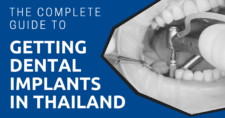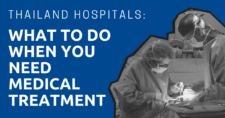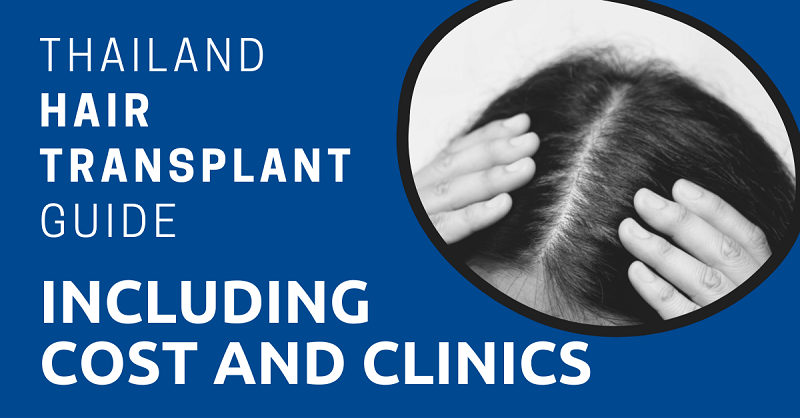
Thinking about getting a hair transplant in Thailand?
Hair transplants are a great way to recover lost hair in the most natural way possible. Some people even say that the process is life-changing and significantly increases confidence.
Since Thailand is known for its medical tourism, there are many clinics you can go to for treatment at affordable prices. But that doesn’t mean you can visit any clinic for a hair transplant.
In this guide, we are going to walk you through everything you need to know about getting a hair transplant in Thailand, including available methods, costs, what to prepare for, and how to choose the right clinic.
We would like to give special thanks to BHI Clinic, a reputable hair transplant clinic in Bangkok, for helping us provide information and fact check this article.
"*" indicates required fields
Disclaimer: This article may include links to products or services offered by ExpatDen’s partners, which give us commissions when you click on them. Although this may influence how they appear in the text, we only recommend solutions that we would use in your situation. Read more in our Advertising Disclosure.
Contents
- What is a Hair Transplant?
- Should I Get it in Thailand?
- Types of Hair Transplants
- Which Method is the Best?
- Costs
- How Long Does it Take?
- Tips on Choosing a Hair Transplant Clinic
- Recommended Hair Transplants Clinic in Thailand
- Visiting Hair Transplant Clinics
- Can I Pay with Health Insurance?
- Risk
- Now, on to You
What is a Hair Transplant?
Hair transplant is an effective way to treat hair loss and baldness. It involves minor surgery that takes follicles from the side or back of your head and transplants them into the bald areas of your head.
The whole process can be done in a day. The surgery itself takes around four to eight hours. After that, you have to wait until twelve to eighteen months until you see the full effects of the hair transplant.
The results of hair transplants can be permanent. This means you only need to do it once in your lifetime.
Should I Get it in Thailand?
Thailand is one of the most popular countries in the world for hair transplants because of the following reasons.
First, there are many experienced hair transplant surgeons in Thailand.
Many hair clinics have experienced hair transplant surgeons who are certified by the International Medical Association on hair restoration surgery, such as ISHRS. This means a higher success rate, and you can also avoid malpractice hair transplants too.
Second, the cost is much more affordable than in many countries around the world. According to Statista, getting a hair transplant in Thailand is two to three times cheaper than getting it in the United States, Australia, or Canada.
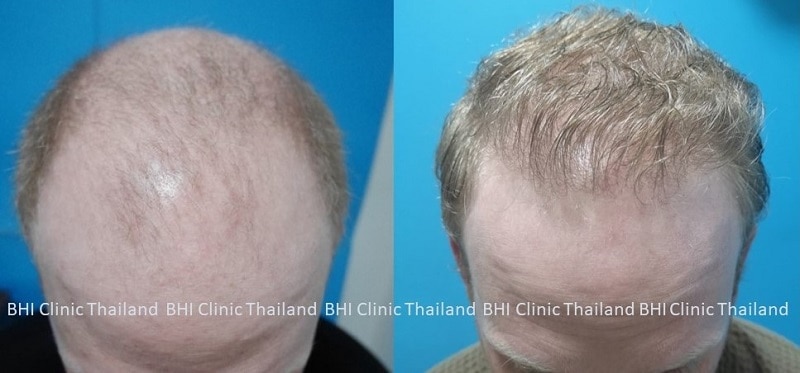
Third, Thailand is a great country for medical tourism. A hair transplant involves only minor surgery. You can fly here to get a hair transplant and explore Thailand at the same time.
Related articles:
- Thailand Hospitals: What to Do When You Need Medical Treatment
- Private Hospitals in Bangkok: The Top and Most Affordable Centers
- How to Pick the Best Hospital for Medical Tourism in Thailand
Types of Hair Transplants
In Thailand, there are mainly four methods of doing hair transplants. These are also the same methods used internationally.
- Follicular Unit Transplantation (FUT)
- Follucilar Unit Extration (FUE)
- Combination between FUE and FUT
- Platelet Rich Plasma (PRP)
Here’s what they mean. Each method also has additional options. For example, you can choose to shave your head or not. There’s also an option to see a preview of the results of your hair transplant within a week.
It’s best to talk to your hair transplant surgeon to find out which types and options are available to you.
Follicular Unit Transplantation (FUT)
FUT is commonly known as a strip method. Basically, a hair transplant surgeon removes a strip of skin from your head for hair follicles and then transplants it onto a balding area.
Although this method has been around for decades, it’s an effective way of doing hair transplants. You can get lots of hair. It’s also more affordable than other methods. However, it leaves a striped scar on your head and can be more painful than other methods.
Follicular Unit Extraction (FUE)
On the other hand, FUE is a newer technique. With this process, the surgeon gathers hair follicles by using a circular punch tool on donor areas. This means there will be no striped scar on your head. Instead, it leaves only small circular scars on your head.
However, the FUE method is more expensive than FUT.
Combination FUT and FUE
This is known as a combo or hybrid technique. You get the benefits of both FUE and FUT methods in order to get the most success growth rate from the hair transplant.
However, it’s a long process that may involve a two-day surgery. Because of this, it’s the most expensive method of hair transplant.
Please note that not everyone is suitable for this method because it depends on your hair condition. It’s best to consult with a hair transplant surgeon.
Platelet Rich Plasma (PRP)
This is more like a hair restoration technique rather than a hair transplant. Basically, a surgeon will draw a small amount of your blood, put it into a centrifuge, and inject it to the bald areas to promote hair growth.
The PRP method needs to be done regularly. In the beginning, you need to do it every month for the first three months and evaluate the effects thereafter.
Some clinics, like BHI Clinic for example, also include PRP free of charge with all of its hair transplant patients to maximize the hair growth success rate.
Which Method is the Best?
Since each method has different pros and cons, there’s no best method out there. It depends on what you need, your budget, and your current hair growth condition.
For example, FUT is affordable with a high success rate. Hair will also look natural with this method as well. But it leaves a small scar (the scar will be covered by your hair), and the process can be painful.
On the other hand, FUE is less painful, and it’s more expensive than FUT.
A combination between FUE and FUT gives a great result but it takes two days to do.
While PRP leaves no scars at all, you need to have the treatment monthly during the first three months. After that, you may need to do it again depending on the results.
In addition, each person has different types of skin, hair, and health conditions.
Rather than trying to find the best method yourself, it’s best to consult with a doctor to find out which one is the most suitable for you.
Costs
You will find a variety of price ranges for hair transplants. Costs, however, usually involves three factors:
- Doctor’s experience: If the hair transplant is done by an experienced hair transplant surgeon, it’s going to be more expensive than an inexperienced surgeon.
- Method: There are several ways you can get a hair transplant, and each has a different price.
- Grafts: The cost of hair transplants is mainly calculated by graft.* The more graft you need, the more money you have to pay.
*Graft is a small piece of tissues with one or more hair follicles. There are normally around one to four hairs per graft. The number of grafts you need mainly depends on your hair condition and expected results. You will know how many grafts you need after seeing a hair loss doctor.
You should be careful of any clinics that offers hair transplants at very low costs.
For example, if a hair transplant with 2,000 grafts only cost you THB30,000, it can be safe to assume that it’s being done by a hair transplant technician rather than a hair transplant doctor.
As mentioned earlier, hair transplant surgery is a long procedure that takes four to eight hours. That price would be too low even for the cost of the doctor’s fee.
This also means you face more risk when getting a hair transplant because it’s not being done by a hair transplant surgeon. In addition, it’s not legal; a hair transplant technician isn’t legally allowed to do hair transplants.
To get an idea on how much you’ll pay, below is a price list for hair transplants from a licensed clinic that the works only with experienced surgeons.
- Hair Transplant (FUT/FUE): THB79 to THB159 per graft
- Beard transplant (FUT/FUE): THB89 to THB119 per graft
- Eyebrow transplant: THB15,000 to THB75,000
- PRP treatment: THB10,000 per session
For example, if you need a hair transplant with 2,000 grafts, and it costs THB79 per graft, then you’ll pay THB158,000.
This price may or may not include consultation fees, medication, and wound cleaning fees.
To get an exact quote, you need to visit a hair loss doctor in person. Then, the doctor can tell you how many grafts you need, and which method will work best for you.
How Long Does it Take?
To get a hair transplant in Thailand, you should prepare for at least a three-day process.
The first day is the consultation, a chance for you to talk to the doctor to find out what’s the best hair transplant method for your case.
The second day is operation day, where you may need to visit the clinic early in the morning and get the procedure done. The operation takes four to eight hours, on average, depending on your hair loss needs.
On the third day, you return to the clinic to clean the hair transplant areas.
However, it’s possible to do everything in a day. You can get an online consultation with a doctor and visit the clinic for a transplant. It’s even possible to clean the area yourself at home.
Tips on Choosing a Hair Transplant Clinic
When it comes to getting a hair transplant, choosing a doctor is more important than choosing a clinic.
Transplanting hair, no matter which method is used, can be complicated. You need to make sure the surgeon who does the hair transplant knows how to do it properly and get the desired results.
After all, hair transplant is a form of surgery. You can’t just visit any clinic and get it done. There’s reports of people who go through turmoil after getting hair transplants at anonymous clinics.
Here’s what you can do to choose the right surgeon.
Don’t Trust Online Reviews
While you might be tempted to find a hair transplant clinic based on a review, it’s actually not a good idea.
This is because hair transplants, as well as other cosmetic surgeries, are big business that involves a lot of money. There are some clinics out there that hire marketing companies to promote their clinics online.
This means the online reviews you see might be posted by a marketing company, rather than real customers.
Check Doctors’ Education, Experience, and Qualifications
Therefore, instead of reading online reviews, you should check a surgeon’s education, experience, and qualifications.
A majority of hair transplant clinics in Thailand, as well as other parts of the world, normally post the profile of their hair transplant surgeons on their websites.
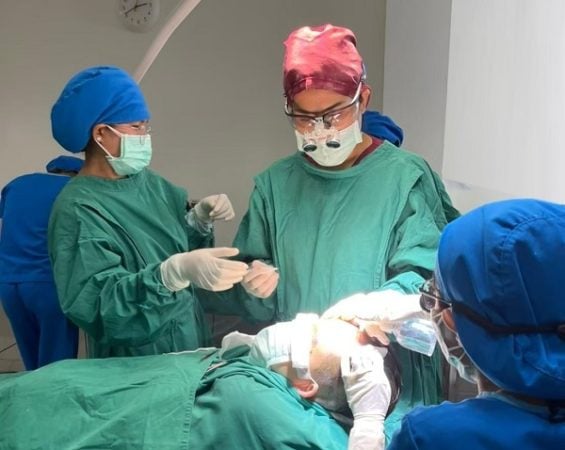
Here’s what you need to do when checking a hair transplant surgeon in Thailand.
Licenses
All hair transplant surgeons in Thailand must be licensed doctors from the Medical Council of Thailand. You can check their license by entering their full name in English on this page.
Here, you will find out how long that doctor has been practicing medicine, as well as their specific skill set.
When it comes to hair transplant, surgery, plastic surgery, or dermatology, a specialist is preferred.
While the page is only available in Thai, you can use Google Translate to convert the text to English.
International Recognition
Another good way to find a qualified hair transplant doctor is to go to a website like the International Society of Hair Restoration Surgery (ISHRS), which is the leading non-profit medical association for hair loss treatment and restoration.
This website has a list of hair loss doctors all around the world, including Thailand.
Please note that there are mainly two types of membership on their database:
- member
- fellow
Only an experienced hair loss doctor will have a fellow status. It basically means that person is a doctor.
In Thailand, there are a few doctors who have the fellow doctor status at ISHRS. One of them is Dr. Kulakarn Amonpattana from BHI Clinic.
Qualifications and Published Works
You can also search the full name of the hair loss doctor on a search engine (like Google) to find out more about which clinics or hospitals they work at, any qualifications they have, as well as any medical papers they’ve published.
Please note that you shouldn’t trust any qualification you see. Having many qualifications doesn’t always mean that the person is an experienced hair loss doctor.
In fact, some qualifications can be had just for attending a three-hour seminar.
Ask the Right Questions
Before visiting a hair loss clinic, you should do your own research on hair transplants and ask the doctor lots of questions to make sure they really know their stuff.
Here are some good questions to ask:
- How many hair transplant surgeries have you performed, and what is your success rate?
- Can you provide before and after photos of previous patients who have had similar hair transplant procedures to mine?
- Can you guarantee the success of a hair transplant? (An ethical doctor is unlikely to guarantee the result. However, they will answer a success rate in percentage after diagnosing your hair condition.)
- Will you be the one who does the hair transplant for me? (This is to make sure it’s not done by someone else.)
If the doctor can answer all of these questions in detail with confidence, you will know you’re in good hands.
Recommended Hair Transplants Clinic in Thailand
In Thailand, it’s more popular to get a hair transplant done at a clinic rather than a hospital because it’s cheaper and more convenient. Some hair clinics may even have better hair transplants facilities than hospitals.
Many hair clinics are run by hair loss doctors, and these doctors may also work part-time at big hospitals.
Let’s take a look at recommended hair clinics in Thailand. Most of these are located in Bangkok.
BHI Clinic
BHI Clinic was founded by Dr. Kulakarn Amonpattana. She is an internationally recognized hair doctor with decades of experience in hair treatment, hair transplant, and hair restoration.

She is a fellow member of the International Society of Hair Restoration Surgery and also the founding member of Asian Association of Hair Restoration Surgeons (AAHRS) and Thai Society of Hair Restoration Surgery (TSHRS).
Because of her skills and experience, hair doctors in Thailand often recommend her to patients with complicated cases.
You can find a wide range of hair treatments, transplants, and restorations at BHI Clinic, from FUT transplants to FUE transplants, combo transplants to scalp micro-pigmentation, eyebrow transplants, and beard and mustache transplants.
Here are its branch addresses and contact info:
- MBK Center: 6th floor, 444 Phaya Thai Rd, Wang Mai, Pathum Wan, Bangkok (Pathumwan Princess Hotel)
- Suvarnabhumi: Chularat 1 Hospital 2nd floor, 68/1 Bang Na-Trat Frontage Rd, Racha Thewa, Bang Phli District, Samut Prakan
- Lat Phrao: SD Building (2nd floor) No. 3 Soi Lad Phrao 111 Lat Phrao Rd, Khlong Chan, Bang Kapi District, Bangkok (located inside Vejthani Hospital)
- Salaya: 223, Krathum Lom, Sam Phran District, Nakhon Pathom
You can contact them directly at +6682-219-9695 or [email protected]
DHT Hair Clinic
DHT Hair Clinic was the first hair transplant clinic in Thailand and has been in the hair restoration business for over 25 years.

Dr. Damkerng Pathomvanich, another well-known hair transplant surgeon, works here.
DHT Hair Clinic has a team of experienced hair doctors. Many of them also work at leading international hospitals in Thailand such as Bumrungrad Hospital and Phaya Thai hospital.
DHT Hair Clinic is located on Pradiphat Road near the Saphan Khwai BTS station.
Samitivej Hospital
If you prefer to get a hair transplant done at the hospital, you can check out Samitivej Hospital near Sukhumvit.

It’s one of the leading private hospitals in Bangkok. The hospital has a dermatology clinic that deals with skin diseases as well as hair loss and hair transplants.
You can get a hair transplant there with Dr. Saroj Suvanasuthi. He works here on Wednesdays, Fridays, and Saturdays.
Yanhee Hospital
Yanhee Hospial is a leading cosmetic hospital in Thailand where you can get a wide range of cosmetic treatments, including hair transplants.

To get a hair transplant at Yanhee Hospital, schedule an appointment with Dr. Prasert Seesillapachai. He’s an experienced hair doctor who is also a member of the ISHRS, Europeron Society of Hair Restoration Surgery, and TSHRS.
Related article: Cosmetic Dentistry in Thailand: Overview, Types of Treatments, & Costs
Visiting Hair Transplant Clinics
When visiting a hair transplant clinic in Thailand, here is what you can expect to do.
Make an Appointment
While it’s possible to walk in to a hair transplant clinic, it’s not recommended. It’s always better to make an appointment.
This is to make sure that when you visit a clinic, you can get a consultation with a hair loss doctor right away.
Consultation
Getting a consultation is the most important part before getting a hair transplant. In this part of the process, make sure that you’re talking to a hair loss doctor instead of a sales representative.
You should do your homework and ask as many questions as possible as mentioned in the previous section above.
After that, the doctor will also check your hair condition and tell you the recommended hair transplant methods, design a hair pattern for you, inform you of the costs, and tell you what you need to do before and after getting hair transplant surgery.
The doctor may check your condition and even recommend that you to get hair treatment instead of a hair transplant.
It’s also recommended to bring a photo of the hairstyle you want to have to help the hair loss doctor design a hair pattern for you.
If it’s not convenient for you to visit the clinic in person, many clinics offer online consultations via video through Zoom, Skype, or Google Meet.
Pay Deposit and Schedule the Surgery
Once you have your consultation, it’s time to schedule your hair transplant surgery.
You may also need to pay for deposit as well, normally THB10,000 on average.
Keep in mind that it’s possible to postpone your surgery if you inform the clinic at least seven days in advance. However, many clinics have a different policy on this. It’s best to check with them in advance.
Prepare for Surgery
There are things you should do before getting the hair transplant surgery, including:
- stop taking certain medications and supplements a week before the surgery, such as Plavix, aspirin, vitamin E, fish Oil, and any other medications related to blood thinning
- inform your doctor if you’re taking any allergy drugs or regular medications
- stop drinking alcohol or smoking at least 24 hours prior to the surgery
Get the Surgery
Here’s what you can expect on the day of your hair transplant surgery. First, you should:
- refrain from drinking coffee, tea, or any caffeinated beverages
- eat only a light breakfast
- have someone accompany you to the clinic
Hair transplant surgery normally takes four to eight hours. There may be a lunch break during the surgery. If so, your meal will be prepared by the clinic.
After the surgery, you can go right back home. Some clinics can also arrange accommodations if you want to stay close to the clinic in case of any possible complications.
After the Surgery
One day after the surgery, you return to the clinic for so staff can clean the surgery area. After that, you can clean it at home with a non-chemical shampoo.
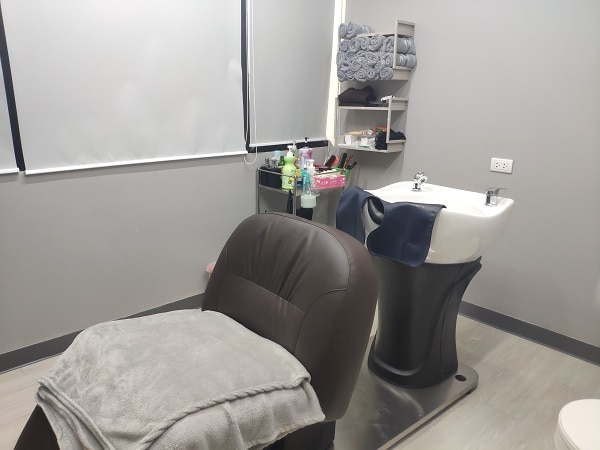
On day seven, you can come back to the clinic again and get another cleaning and stitches (for FUT only).
You should avoid direct sunlight and exercise until day fourteen. During this time, your new hair will fall out. This is completely normal and will grow back again soon.
After one month, you can go back to normal everyday activity, including water sports and getting your hair cut or colored.
After three to six months, you can even tattoo the transplanted area.
During the first six to eight months, your new transplanted hairs may grow out curlier than your natural hair. But it will grow straighter and thicken overtime. You should see full results of your hair transplant in 12 to 18 months.
You should get a list of instructions on what to do before and after getting the hair transplant surgery from the hair transplant clinic.
Pay for the Hair Transplant
You’re expected to pay in full before getting the hair transplant. If you have a Thai bank account, a wire transfer is recommended.
On the other hand, a hair transplant clinic in Thailand prefers cash over international money transfers or credit cards.
This is because international money transfers take a few days until the payment clears.
If you want to pay with a credit card, you should contact your credit card provider in advance and tell them about this cost. Otherwise, the credit card company could block the payment assuming that it’s a scam because hair transplants involve a lot of money.
Read more:
- Opening a Thai Bank Account: A Guide for Expats and Tourists
- Thai Baht: How to Get the Absolute Best Exchange Rates
- How to Send Money to Thailand: The Fast, Cheap, Reliable Way
Can I Pay with Health Insurance?
Similar to other cosmetic surgery, the chance is that the insurance company won’t pay for the cost of hair transplant.
This is because health insurance mainly covers for treatment that’s medically necessary for your health condition or injury.
You can find out more on our easy guide to health insurance in Thailand.
Risk
Since hair transplants are essentially surgeries, there are certain risks involved including bleeding, swelling, and itching on the hair transplant area.
There will also be some scars left, but it won’t be visible unless you shave your head.
If you get the hair transplant at an illegal clinic, there are other major risks involved including:
- prominent scaring
- bad hair patterns
- poor hair growth
- infections
- baldness
ISHRF posted a warning of illegal hair transplant markets on its website.
This is why it’s important to go to an ethical clinic rather than visit the one with the cheapest costs available.
Now, on to You
While there are many places to get a hair transplant in Thailand — as well as other countries — it’s always important to check the qualification of the doctor who’ll be doing the hair transplant. This will ensure that you have a better chance at a successful transplant while avoiding the risks that come with malpractice.
If you want to get a hair transplant in Thailand, check out BHI Clinic. Its hair transplants are always done by an experienced hair transplant surgeon. They also have an English speaking support team that can help you throughout the process.





